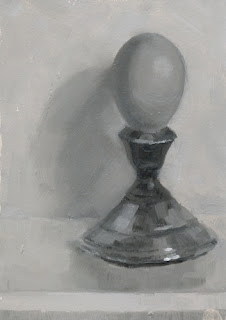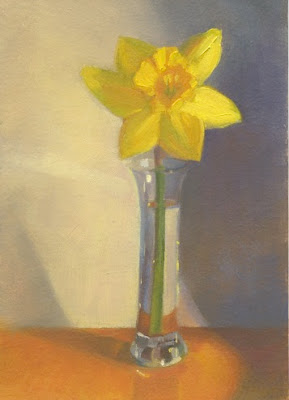Well, you've met the kitties. This is my son, Stefan, proud owner of Fred and Jacques. Working from a photo, which I haven't often done, I found it easier to focus on other aspects of painting. The drawing stage is easy since Stefan didn't move a bit! The fact that it's already two dimensional made it easier to see the colors and values of the photo, too, I suspect. I started this painting in Cameron's class and once again, was so excited, I couldn't wait to work on it at home. I stayed up late and nearly finished it and then tweaked it once or twice after that. I'm glad I captured Stefan in his teens. Now I need to do another painting of my older son, Marc, using what I've learned. Hopefully Marc will pose for me again...live. (I do prefer that!)
In between, I've experimented on my smaller paintings using Liquin and then no medium, thin, thick, fluid and not. Eventually I'd like to combine techniques. So much to learn and sometimes it feels like there's so little time! Having fun, though. Thanks for visiting!
Thursday, May 26, 2011
Tuesday, May 24, 2011
Kitties! Meet Fred and Jacques, 6x8"
Over the last few months, our younger son has been begging and then showing his maturity and readiness to care for his/our new family members: Fred and Jacques. The brothers put smiles on our faces with their antics. Although I'm helping Stefan out a little with the cat chores, he's doing a really good job! For this commissioned portrait, Stefan has asked me to work a little bit more on their eyes.
Monday, May 23, 2011
After Degas—Portrait of a Young Woman
Every once in awhile I love to copy a master painting. From exercises like this I can learn so much: color mixing, painting techniques that are new to me, composition, and even drawing skills. Because I initially had such difficulty with the painting, I stopped and drew her first.
Sunday, May 22, 2011
After Sargent, Carmela Bertagna, 11" x 14"
I thought I'd catch you up with other work I've been doing. I'm taking a class with Cameron Bennett, concentrating on portraits. Use of any medium is not allowed where the class is held, so we do without it. What an experience! I actually enjoyed it. I was so excited that I couldn't wait to work on it once I returned home (at 9 pm). I forgot that I tried painting without medium once before, but it didn't feel comfortable to me then. I loved the ease of sketching lightly with paint to start and then building up the paint, making it thicker. This photo was taken in north light (the canvas looks very cool); I used my cell phone, since I had no camera handy!
Monday, May 16, 2011
Three Tulips, 6x8"
I learned a lot from this one, and with more reflection, (in my head, not on the vase), I think I'll understand more. Down time is so important for looking at your work, understanding what you've learned, and what you need to improve. I'm very happy with the vase and wonder if parts of the main flower need to be darker or lighter. Sarajean rightly pointed out that the cast shadow of the vase should be darker. It was—at one point in the painting process! Why did I change it? I don't know. I wasn't careful with my value families! I definitely need to fix that. So, I'm about to give myself a little time to look, learn, and regroup. I'll be back—so see you soon!
Sunday, May 15, 2011
Value Study, The Youngster. 5x7"
I painted this after "The Lady". I was careful to use the five-value scale and took some liberties in blending some of the paint. Guess what? The shadow on the shelf needs to be darker! Notice, the light side of the brown egg is the same value. Paint and learn! So is part of the shadow on the wall. Perhaps my five-value scale didn't offer enough values? I will tweak this though, and see what happens. Right now the candlestick looks like it's floating. Can't have that!
Saturday, May 14, 2011
Values, poster study—The Lady, 6x8"
Here's an exercise I did with Sarajean. We mixed our values carefully and applied the paint in an organized way so we could see and understand the effect.
In case you haven't figured out what you're looking at (color here would help), I'm sure you must see what I do: it's a Lady, dressed ever so elegantly. (Okay, it's an ice cream dish overturned, with a clementine sitting on top—it's bottom.)
In case you haven't figured out what you're looking at (color here would help), I'm sure you must see what I do: it's a Lady, dressed ever so elegantly. (Okay, it's an ice cream dish overturned, with a clementine sitting on top—it's bottom.)
Friday, May 13, 2011
A Daffodil, 5x7"
This daffodil from the garden posed such a challenge, as do all flowers for me. The colors are so subtle; the shift from warm to cool can be surprising. I may try to tweak this if I can figure out what it needs. I may have violated the value families! eek. It could be that the petals in the shadow should really be darker. What do you think? Yellows sometimes confound me. How about you?
Thursday, May 12, 2011
Forsythia at the Lake—Study, 6x8"
Well, one misty, overcast, drippy day I drove to local Lake Quannapowitt to paint "en plein air" from my car. Here you have it.
There's a story the painting doesn't reveal: while painting from my car I listened to the radio. The day warmed up as I was nearing the end of my painting session. It was humid and warm. I turned on the air (not a/c) and opened the windows. Suddenly my radio stopped working! YES! My battery died. Happily AAA came to the rescue in time for me to pick up my son from school. Silly me. Lucky me.
There's a story the painting doesn't reveal: while painting from my car I listened to the radio. The day warmed up as I was nearing the end of my painting session. It was humid and warm. I turned on the air (not a/c) and opened the windows. Suddenly my radio stopped working! YES! My battery died. Happily AAA came to the rescue in time for me to pick up my son from school. Silly me. Lucky me.
Wednesday, May 11, 2011
Values—Teapot, 6x6 inches
After the sphere, it seemed natural to paint Sarajean's teapot. We premixed the values and then happily applied paint, not really adhering to a systematic approach. From classes I took with Dennis Perrin, I learned the importance of keeping the value families distinct. (And that's what I'm still trying to master!) Whatever is in the shadow stays in the shadow value range. The lights stay in the value range for the lights. You've may have heard the seemingly confusing statement: the darkest dark in the light is always lighter than the lightest light in the shade. (I am now feeling confused myself! I hope I wrote that correctly!) If you've never experienced this or can't imagine it, you could put a black piece of paper in the light and a white piece of paper in the shade and check it out!
Related to that, reflected light in a shadow (as you see in the belly of the teapot) often appears to be lighter than it actually is. Why? Because it's surrounded by darker values. A small hole punched in cardboard can help you isolate the colors and compare them. It's easy to overstate the lightness of reflected light. To make it convincing, I always try to keep it in the value range of the darks. (Thank you Dennis Perrin.)
Tuesday, May 10, 2011
Values
If you don't receive Fine Art Views Newsletter, you may wish to check it out: http://faso.com/fineartviews/30732/put-the-fire-out. Keith Bond's article that arrived in my email this morning touches on just what Sarajean and I have discovered: we need to address and master one problem at a time and have decided to focus on values to start. Occasionally I'll share what we do.
We painted value scales to help us understand the intervals from white to black. As you can see, we did a ten-step value scale, then nine (thinking it would be easier to mix and judge steps that are equidistant from others, since we painted the white and black first, and then mixed the value between each time), then five, which would be good for poster studies. In these exercises, we mixed a black using black and burnt umber, so it would dry faster and not be tacky once dried. We used palette knives to mix and paint, to keep the values clean. I'm not positive my value steps are evenly spaced, but they're close, I hope! Expert eyes would be so welcome, but I imagine even imperfect exercises could lead to eventual mastery.
The sphere here, was painted prior to the formal value scales, but we did limit ourselves to five values to begin, I think. We also allowed ourselves to play with warm and cool temperatures. Rather than keeping it a simple poster study, I tried to figure out how to paint it "realistically." Perhaps this dealt with more than one problem! oops.
Independently, Sarajean and I will practice our exercises and continue to paint whatever and however we wish. If you'd like to share exercises that you found helpful, please do! I'll be happy to make your comments visible so we can all benefit. I expect to be posting more frequently since other demands are quieting down some. Take care and thanks for visiting!
Subscribe to:
Posts (Atom)











